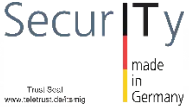An information security management system (ISMS) is a systematic approach to managing sensitive information within an organization. It is a framework that helps organizations establish, implement, maintain and continuously improve their information security processes. The main objective of an ISMS is to ensure the confidentiality, integrity and availability of information assets while effectively managing risks.
The abbreviation ISMS is sometimes used analogously for software (ISMS tools), which can assist in planning, implementing and further developing an ISMS.
PDCA cycle
An ISMS provides a structured set of policies, procedures, guidelines and controls to manage information security risks. It takes into account the company’s specific business requirements, legal and regulatory obligations, and stakeholder needs and expectations. The ISMS typically follows a PDCA cycle typical of organizational processes:
- Plan – Plan – Risk-based planning of actions.
- Do – Implement/Apply – Implement the measures
- Check – Conduct assessments and reviews
- Act – React & Improve – Correction or improvement of measures
ISMS structure
The structure of an ISMS usually follows a framework based on international standards such as ISO/IEC 27001 or national standards such as BSI-Grundschutz. The core elements of an ISMS are:
- policy: The ISMS begins with an information security policy, which is an overarching document that outlines the organization’s commitment to information security, its objectives, and the framework for implementing security controls. Roles and responsibilities of key stakeholders are defined here.
- scope: the scope defines the boundaries of the ISMS and identifies the assets, processes, departments or locations that the system covers.
- risk assessment: organizations conduct a comprehensive risk assessment to identify and evaluate potential threats, vulnerabilities, and impacts to their information assets. This helps determine the security controls needed to effectively mitigate risks.
- risk treatment plan: Based on the risk assessment, a risk treatment plan is developed that describes the actions and controls to be implemented to address the identified risks. This plan identifies the actions, responsibilities, timelines, and resources required to mitigate the risk.
- implementation of controls: This phase includes the implementation of various security controls, such as physical security measures, access controls, encryption, incident response procedures, and employee awareness training. These controls are selected based on the organization’s risk appetite and the requirements of relevant standards or regulations.
- performance monitoring: once controls are in place, organizations continuously monitor their effectiveness and measure the performance of the ISMS. This may include regular audits, vulnerability assessments, security incident tracking and reporting.
- management review: Periodic management reviews are conducted to evaluate the overall effectiveness of the ISMS. This includes evaluating security metrics, reviewing incidents, analyzing performance data, and making any necessary adjustments or improvements to the system.
- continuous improvement: an ISMS is a dynamic system that requires continuous improvement. Organizations should identify areas for improvement, learn lessons from incidents or audits, and take corrective and preventive actions to strengthen the security posture.
Conclusion
It is important to note that the structure and specific implementation of an ISMS may vary from one organization to another, depending on their size, industry, and individual requirements. The outlined components provide a general framework for establishing and maintaining an effective ISMS.
Bosch CyberCompare can support you in establishing an ISMS at any stage of the project with good practice know-how from a variety of projects. In addition, we have a good view on the market of ISMS IT tools. If you want to get information about features and costs, compare vendors and approaches, please contact us at cybercompare@de.bosch.com.
Please remember: This article is based our knowledge at the time it was written – but we learn more every day. Do you think important points are missing or do you see the topic from a different perspective? We would be happy to discuss current developments in greater detail with you and your company’s other experts and welcome your feedback and thoughts.
And one more thing: the fact that an article mentions (or does not mention) a provider does not represent a recommendation from CyberCompare. Recommendations always depend on the customer’s individual situation.






